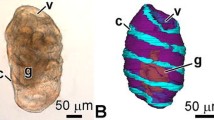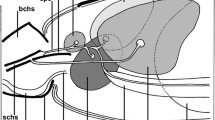Summary
Electronmicroscope observations of the pharynx of the 2nd stage infective larva reveal that it is devoid of musculature and is therefore incapable of any pumping activity. By the 8th day when the larva is situated in the host lung however, the radial muscles are well developed and the organ appears to be fully functional.
Active secretory glands are present in the pharynx of both the infective and lung stage larvae but those of the latter contain a greater variety of secretory bodies. It is suggested that the pharyngeal glands of the infective larva secrete lytic substances to facilitate host tissue penetration whilst the secretory products of the lung stage larva are concerned with a more diverse range of functions including feeding.
No valve like structure was discernable at the pharyngeo-intestinal junction of the larvae recovered from the host lungs 8 days after infection. It is suggested that the cells of the pharyngeo-intestinal junction, function as a shock absorber between the highly mobile pharynx and the relatively static intestine.
Similar content being viewed by others
References
Carpenter, M. P. F.: The digestive enzymes of Ascaris lumbricoides var. suis; their properties and distribution in the alimentary canal. Dissertation. Univ. Michigan. Univ. Microfilms, Publ. no 3729. Ann. Arbor, Mich. 183 pp. (1952).
Jenkins, D. C., Erasmus, D. A.: The ultrastructure of the intestine of Ascaris suum larvae. Z. Parasitenk. 35, 173–187 (1971).
Lee, D. L.: The distribution of esterase enzymes in Ascaris lumbricoides. Parasitology 52, 241–260 (1962).
The ultrastructure of the alimentary tract of the skin-penetrating larva of Nippostrongylus brasiliensis (Nematoda). J. Zool. 154, 9–18 (1968).
Mapes, C. J.: Structure and function in the nematode pharynx. I. The structure of the pharynges of Ascaris lumbricoides, Oxyuris equi, Aplectana brevicaudata and Panogrellus silusiae. Parasitology 55, 269–284 (1965).
Structure and function in the nematode pharynx. III. The pharyngeal pump of Ascaris lumbricoides. Parasitology 56, 137–150 (1966).
Reger, J. F.: The fine structure of the fibrillar network and sarcoplasmic reticulum in smooth muscle cells of Ascaris lumbricoides (var. suum). J. Ultrastruct. Res. 10, 48–57 (1964).
Author information
Authors and Affiliations
Rights and permissions
About this article
Cite this article
Jenkins, D.C. The ultrastructure of the pharynx of some developing larvae of ascaris suum . Z. F. Parasitenkunde 37, 255–266 (1971). https://doi.org/10.1007/BF00259332
Received:
Issue Date:
DOI: https://doi.org/10.1007/BF00259332




